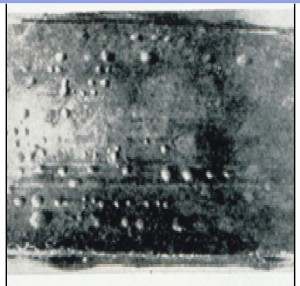H2S can either be occurred naturally in reservoir or produced by chemical/biological reactions. For example, the souring of field by water re-injection caused by Sulphate Reducing Bacteria (SRB) is well known by the oil and gas industry.
H2S corrosion is less aggressive in general metal thinning for mild carbon steel since the its corrosion product FeSx, both Mackinawite and Pyrrhotite , are tense textural tending to prevent further reaction of metal with corrodant (H2S ).
Galvanic effect
FeSx is very conductive, which may avenue the galvanic corrosion of steel by acting as cathode. Spalling of FeSx exposes small anodic surface (steel) over large cathodic area ( FeSx), which may result in severe pitting corrosion.
Flow Velocity effect
In sour crude gathering line, the low velocity will allow FeSx settling. The galvanic effect between FeSx and pipe will accelerate the corrosion rate dramatically.
Monitoring error
FeSx also poses issues for ER probe in sour service due to its low resistivity. It may distort the corrosion rate trending significantly.
Impact of pH on H2S corrosion
pH<2 :The deposition of iron sulphide is not likely, accelerating the dissolution of iron
3<pH<5: Forming of FeS scale, which is corrosion inhibitive to further corrosion
Complexity with H2S is its reaction activity. The product of its reactions will lead to further corrosion. for example, although it appears temperature has little impact on the H2S corrosion mechanism. However, higher temperature will assist the sulphur modification of elemental sulphur. Sulphide can be oxidised with any oxidant to produce elemental sulphur as noted:
2H2S + O2 = S + 2H2O
The elemental sulphur can further react with Iron to form Iron sulphide scale. Field experience has shown that elemental sulphur is very aggressive on metal in moisturised environments, particularly for pitting corrosion, stress corrosion and general corrosion.
Summary
In general sense, the H2S corrosion rate reduces with lower temperature, lower partial H2S pressure, and dosing of appropriate corrosion inhibitors. It increases with strong turbulence , oxygen ingression and microbial activity.
The most of concern by the presence of H2S is stress cracking. Since H2S is acidic and reaction of steel produces iron sulphide and monatomic hydrogen, which may result in a number of different failure mechanism such as hydrogen derived microblisters, pitting and cracking. These are the contribution to more catastrophic failure of sulphide stress corrosion cracking in susceptible metals and alloys. There are number of guideline to discuss H2S Stress corrosion cracking management (CEPA), testing(EFC 16), materials selections (NACE MR 0175) and assessment (NACE SP0204).

